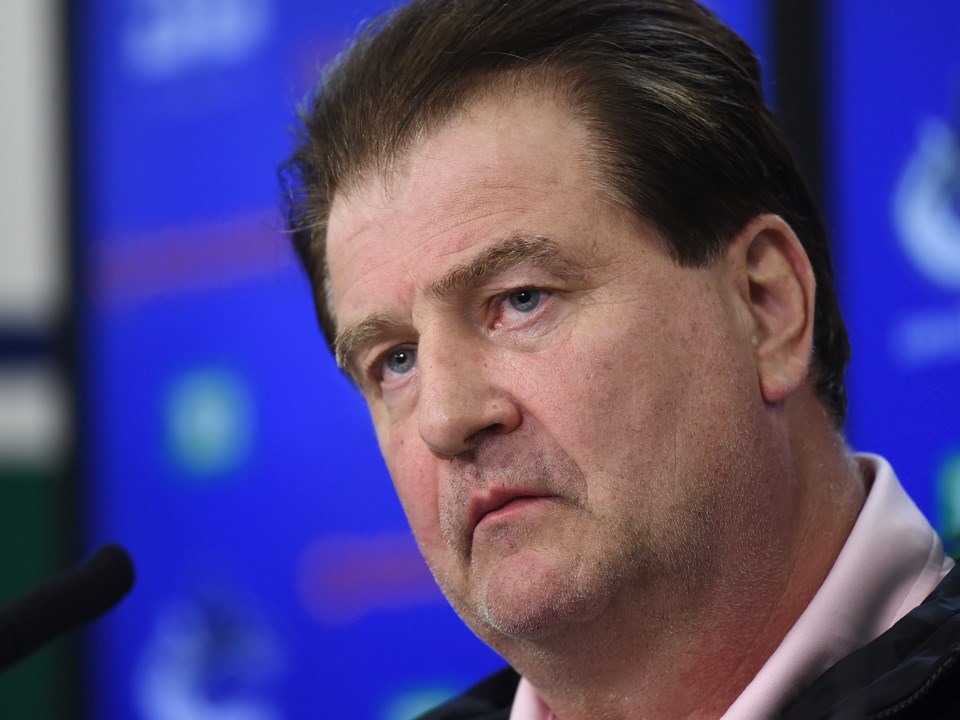The Canucks may not have a pick until the third round, but they’ll still be aiming for the “best player available” when they make their first pick.
The 2020 NHL Entry Draft kicks off on Tuesday, but the Canucks are expected to have a quiet day. Barring a blockbuster trade that gains them a first-round pick, they won’t be drafting anyone until the second day of the draft on Wednesday.
While the Canucks have some clear needs in their prospect pool, they won’t be drafting for positional need, at least not with their first couple of picks.
“I talked to Todd [Harvey] yesterday,” said Canucks GM Jim Benning on Monday. “It’s still important in the third round...when we’re making that pick, let’s take the best player available. Let’s take the best player that we think can grow into a real good player at the NHL level, even if it takes more time for that player to develop.”
Harvey played 11 seasons in the NHL after he was drafted 9th overall by the Dallas Stars in 1993. After retiring, he went into coaching before taking a job as an amateur scout with the Canucks in 2017. After three years as a scout, he finds himself in charge of the Canucks draft in a rather unusual year.
“Not being in the same room and being able to have a meeting like we usually do, trying to work with the Zoom calls and having everybody on it, that's been a big change,” said Harvey. “It's been good with the video, all the scouts can see everybody play, whereas usually the regional guys don't get to see guys outside their region, but with this, they've had opportunities to see other players and compare them with players in their region.”
As we’ve seen from past behind-the-scenes videos at Canucks scouting meetings, the team will typically head into the draft with a list of 45 players, supplemented by positional lists. That may not seem like a long list — 217 players get drafted — but it’s typical around the NHL. Prospects that other teams rank highly will end up on “Do Not Draft” lists for other teams for various reasons: concerns about skating, hockey sense, or their ability to take the next step in the coming years.
When they talk about drafting the “best player available,” they’re likely talking about drafting the top player on their “45” whereas drafting by need generally means they’ve exhausted their list of 45 and will start dipping into their positional lists to fill a gap in their prospect pool.
“Maybe from the fifth round on, that's when we'll start concentrating on — when things are kind of all the same — on positionally trying to get some more centre icemen or a specific type of defenceman,” said Benning. “But our first couple picks, the third and fourth rounds, let's just pick the best player available that we think can grow into an NHL player.”
Essentially, at some point in the draft, the differences in potential between prospects are so fine that it’s nigh-impossible to properly rank them. For the Canucks, this will likely mean their picks in the 5th, 6th, and 7th round will go towards filling a positional need. According to Benning, one of their biggest gaps is at centre.
“I think we’ve got some depth on defence now,” he said, “and then with Höglander, Podkolzin, and Kole Lind, we’ve got some guys on our wings that we think are going to come in and play for us and be good players. So I guess that centre is a position that if we can keep trying to get some depth there, then we’re going to look to do that.”
After trading Tyler Madden in the Tyler Toffoli deal, the top centre in the Canucks’ prospect pool is 25-year-old Marc Michaelis, who they signed out of the NCAA in March. After Michaelis, there’s Carson Focht, Linus Karlsson, and Arvid Costmar, but all face long odds to make the NHL. If the Canucks can improve those odds by adding another centre or two to the pool, that would be ideal.
The Canucks won’t be alone in their pursuit of centres at the draft.
“Centre is a position that, for whatever reason, the last two or three years all NHL teams seem like they're looking for center icemen,” said Benning. “There are some guys that we really like and if they’re there for us in the mid-rounds, then we’ll pick them to try to build up our centre prospect pool.”
It shouldn’t come as a surprise that NHL teams value centres in the draft. Centres frequently have a more-developed two-way game and are better playmakers at the junior level, two elements that make it easier for centres to transition to the NHL, where many centres end up playing on the wing anyway. Typically speaking, NHL teams will value a centre more than a winger, paying them more money, paying a higher price in trade negotiations, and ranking them higher at the draft.
J.T. Miller, for example, was drafted as a centre and has spent some time at centre in the NHL, but has primarily played on the wing. His value for the Canucks last season was clear, as he played on the wing with Elias Pettersson, but took the vast majority of the faceoffs and could keep up with Pettersson’s game in terms of playmaking and hockey sense.
So, don’t be surprised if the Canucks take a centre or two in the final few rounds of the draft on Wednesday. If the draft lines up right, a centre might even be the “best player available” in the third round.




